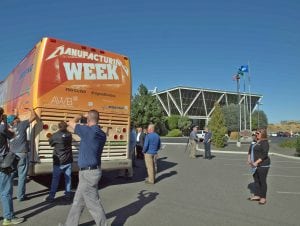Association of Washington Business’ bus rolled into Tri-Cities earlier this month as a part of its inaugural, statewide bus tour in support of the state’s manufacturers.
The Tri-City stops included Delta High School, Lampson International and Barnard Griffin Winery.
It makes sense the region was included in the statewide showcase as Benton and Franklin counties provide 7,733 manufacturing jobs through 236 manufacturers, according to 2016 state Employment Security Department statistics.
Community leaders and elected officials from across the state hit the road with the AWB on two buses Sept. 29 from Port Townsend to kick off the six-day tour. The route covered 2,000 miles and included nearly 60 company visits intended to highlight the importance of the state’s manufacturing sector.
“Manufacturing in Washington is an international success story,” said Kris Johnson, AWB president and CEO. “The products made in our state are recognized as innovative and truly world class. At the same time, we know manufacturers are facing some significant challenges, from finding enough skilled workers to staying competitive in a global economy.”
The U.S. Bureau of Economic Analysis and U.S. Census Bureau report manufacturing industries employ more than 284,500 people throughout the state, or 9 percent of the work force, producing nearly $60 billion worth of goods annually, or 13 percent of the gross state product.
Exports are the main drivers of Washington’s manufacturing economy, with a 62 percent growth in manufactured goods from 2010-16, according to the U.S. Census Bureau and International Trade Administration.
“A lot of major manufacturing happens in rural areas,” said Colin Hastings, executive director of the Pasco Chamber of Commerce. “Rural areas depend on these jobs, and trade is extremely important to the region.”
Maintaining a skilled manufacturing work force is key to the industry’s success, which is why the bus stopped in at Delta High School, a science, technology, engineering and math, or STEM-focused school.
“It presents great careers and pathways for young people,” said Jason Hagey, AWB’s vice president for communications.
“The tour has really shown the diversity of the manufacturing sector,” Hagey said.
Kate Lampson of Lampson International said her family-owned company has been a member of AWB for a long time.
“It’s rare in this day and age to be a family-owned company in manufacturing,” she said. “We’re proud to be third-generation family-owned and actively involved.”

Kate Lampson and her brother, Peter Lampson, both work at Lampson under their father, Bill Lampson, president and CEO. They plan to carry on Lampson’s legacy.
“We are really fortunate to have fathers, sons, and daughters—also third generation—lending a lot of experience and expertise to the work that we do in our organization,” Kate Lampson said.
The AWB tour bus stopped by Lampson’s headquarters in Kennewick to give employees an opportunity to sign the bus’ Manufacturing Week vinyl wrap.
Signatures also were collected for a petition to reinstate a manufacturing tax cut Gov. Jay Inslee vetoed earlier this year.
Senate Bill 5977 would have lowered the business and occupational, or B&O, tax rate by 40 percent for some 10,000 manufacturing firms across the state.
After the bus signing, the tour stopped to climb a Lampson crane. The largest land-based, mobile crane in the world with its 400-foot main boom and hydraulic-driven hoist can lift 3,000 tons, Kate Lampson said.
“We build, design and fabricate every part; it isn’t just a giant tinker toy,” said Bruce Stemp, Lampson’s director of safety. “Everyone talks about German engineering … but we’re every bit as good, if not better. We’re second to none.”
Kate Lampson reported the crane is due to be deconstructed next spring and shipped to Japan, where it is intended to be used in the country’s recovering nuclear sector.
Stemp said it will take eight to 10 weeks to reconstruct the crane on-site in Japan. Lampson’s 2600 series crane takes six weeks compared with other competitors’ models, which can take three months to two years to reassemble.
The Kennewick-based company prides itself on limiting costs contributing to the customer’s bottom line, which can be severely affected by long lead times since the customer pays rent on the crane during reconstruction.
“We really want to get it out on a job to see how it performs, so we can see how to continue to improve,” Stemp said.
Lampson International operates throughout the U.S., Canada and Australia, where it worked on the construction of the Australian Olympic stadium.
“There really isn’t an industry that we haven’t touched,” Stemp said.
“So how do we not only keep, but grow Lampson?” Johnson said. “Economic prosperity throughout all of the state. We have to keep growing.”

